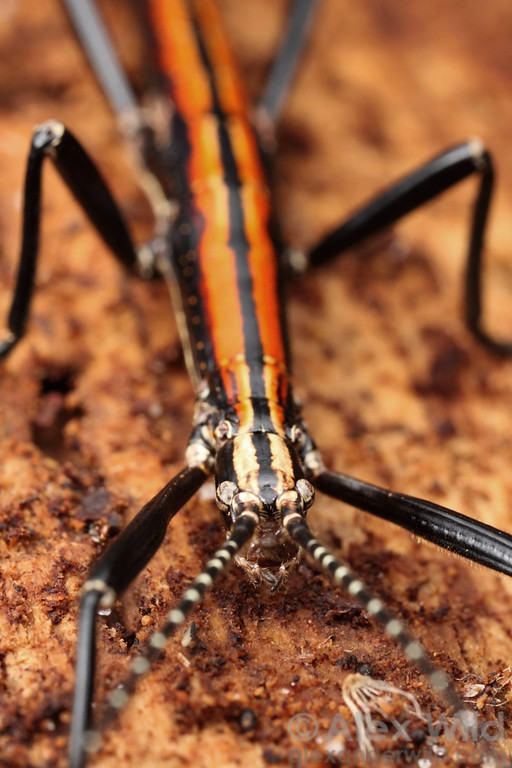Form and Function

Unlike most species of mammals and birds, the female Anisomorpha buprestoides is consistently much larger than the male both in length and width in all three sections of their bodies: the head, thorax, and abdomen. On average, the female body length ranges from 5.80 cm to 8.50 cm, while the male body length ranges from 3.80 cm to 5.20 cm (Conle et al. 2009). In fact, the males are small enough in proportion to the females that they almost continuously ride on the females’ back.
Because these insects do not have skeletons as we do, the entire body of both the male and female is encased in a rigid exoskeleton or cuticle comprised of chitin, a polymer of a glucose derivative. The exoskeleton protects the insect, gives it shape and structure, and allows for muscle attachment to aid in movement. Unfortunately, it does not grow as A. buprestoides does and must be molted periodically and then reformed.
The head, which is nearly oval in shape, encloses the walking
stick’s brain and oral cavity. The head also includes two
compound eyes composed of many individual photosensitive lenses that
absorb light from different directions (Littig 1942). These
lenses give the insect a greater viewing angle and improved detection
of quick movement in comparison to the simple eyes of humans. In
addition, two antennae extend from the head of A. buprestoides that
serve as sensors, detecting surroundings, odors, and temperature
(Sharp 2014). The antennae are therefore incredibly important
for the walking stick’s survival and extend longer than two-thirds of
the length of the body, reaching an average of 4.20 cm in the females
and 3.56 cm in the males (Littig 1942).
The thorax of the walking stick has three segments—the pronotum,
mesonotum, and metanotum—and connects the head and abdomen. In
the female, the thorax is rather stout and around 2.82 cm in length
(Littig 1942). The male thorax has a length of about 1.60 cm
(Littig 1942). The thorax also acts as the attachment point for
all three pairs of legs, each of which are jointed and segmented into
a femur, tibia, and tarsus to allow movement. The tarsus has
claws and suction pads, which allow them to climb different surfaces,
such as tree trunks or plant stems, successfully. The legs are
all long and slender, thus meeting the needs for the walking stick’s
unhurried and deliberate stride (Littig 1942). The thorax also
produces and stores an acidic, milky compound that can irritate and
temporarily blind an attacker. This secretion is released, when
needed, through two prothoracic glands located behind the head on the
dorsal side of the thorax. A. buprestoides can immediately
respond to advances from a predator and accurately hit its target from
up to 30 to 40 centimeters away (Thomas 2003).
Finally, the abdomen of the walking stick makes up roughly half of the body length. Again, the female’s abdomen, about 3.69 cm long, is thick and tapers off at the end, while the male’s abdomen, about 2.33 cm long, is thin and remains the same width throughout each segment (Littig 1942). The abdomen includes the insect’s digestive and reproductive systems. Both the abdomen and the thorax contain numerous spiracles, or small openings on the side of the body, which pass air into the body via tubes (Sharp 2014). The abdomen then contracts and expands as the gases travel into and out of the body to facilitate breathing.
While the southern two-striped walking stick has been found in a
relatively small range of states including Florida and those along the
Gulf Coast, each of the three distinct color forms within the species
has adapted to different environments, resulting in variations in both
morphology and behavior. The most prominent difference is the
color of the two longitudinal dorsal stripes on the insect: white,
orange, or brown. Altogether, these stripes are striking in
contrast to the black stripes that run down the center of the back and
on the sides, and do not provide excellent camouflage in close
proximity. Instead, it is believed that the vivid stripes hint
at the walking stick’s irritating defensive spray and serve to ward
off predators (Conle et al. 2009).

However, an alternative hypothesis suggests that the colored stripes do aid in camouflaging A. buprestoides in specific settings (Conle et al. 2009). The white form is normally well hidden from aerial predators, such as birds, when walking along white sand. The orange form is often found resting on plants with yellow or orange flowers, effectively blending the bright orange stripes. Similarly, the brown form spends most of its day hiding in the brown bark of pine or oak trees. It is likely that such behaviors heavily influenced the success of each color form in their varying environments.